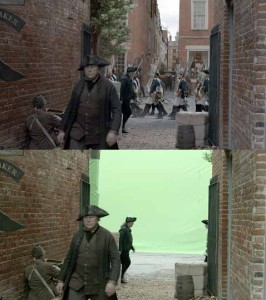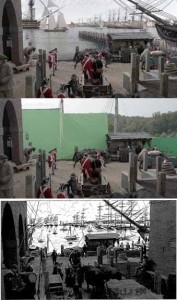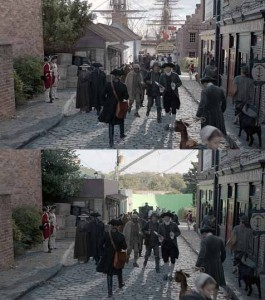![]()

The show centers on an unlikely group of espionage agents based in the small town of Setauket, New York, who help turn the tide of the war.
The show is shot on location, using Williamsburg, Virginia as a stand-in for Philadelphia and Petersburg, Virginia for New York. Setauket scenes are shot on a location-built set. Much of the work for the visual effects team centers on adding details in the form of set extensions, matte paintings, water and other elements to make the real-world locations conform to the historic sites.
“Our job is to create things that are either too expensive or too large to build,” explained production visual effects supervisor Terry Windell. “We aim for feature quality in the visual effects, but we are working with deadlines and budgets that are not what you get on a feature, so we have to be very efficient and smart.”
 FuseFX’s work for Turn involves close collaboration with production staff, including Windell, the executive producers, the show’s directors, production designer Caroline Hanania, cinematographer Martin Rush and co-executive producer/unit production manager Henry Bronchtein. Hanania’s set designs and drawings, for example, serve as the starting point for set extensions and matte paintings.
FuseFX’s work for Turn involves close collaboration with production staff, including Windell, the executive producers, the show’s directors, production designer Caroline Hanania, cinematographer Martin Rush and co-executive producer/unit production manager Henry Bronchtein. Hanania’s set designs and drawings, for example, serve as the starting point for set extensions and matte paintings.
In crafting its contributions to these historical illusions, FuseFX relies on Hanania’s extensive research and conducts additional research of its own. “Many of our building references come from photos of Dutch buildings that used to be in New York,” explained FuseFX VFX supervisor Jon Massey. “Since nearly all of those are gone, we look at European buildings from that same time period, for instance from the Dutch Quarter of Potsdam, Germany.”
The matte paintings used to turn Williamsburg into colonial Philadelphia and Petersburg into New York also feature digital representations of iconic structures such as Independence Hall and Trinity Church. Additionally, the VFX crew is responsible for removing any modern elements, wires and telephone poles, captured in the production footage, and for adding musket smoke and blood wounds that production is not able to capture.
Careful research also goes into the creation of CG ships. “The HMS Victory, Admiral Nelson’s flagship, which dates from the same era, still exists in England and there is a lot of good reference related to it,” said Massey. “That has been very valuable to us.” He added that the attention to detail extends to the flags flown by the ships. “The flag used by the British Navy in North America at that time was the Red Ensign, where the Union Jack appears in an upper corner against a red field. It was the precursor to the flag of the United States.”
 “A mistake will be noticed,” Massey said. “There are websites dedicated to research on the show and a lot of history buffs who watch it. Production invests considerable effort into getting the details right and we try to hold up our end as well.”
“A mistake will be noticed,” Massey said. “There are websites dedicated to research on the show and a lot of history buffs who watch it. Production invests considerable effort into getting the details right and we try to hold up our end as well.”
One of the biggest challenges for the VFX team is water. The real-world Setauket is a harbor town on the Atlantic, but the set representing it is inland. Waterfront views therefore need to be added to most exteriors. Convincing CG water effects can be time-consuming to produce, but FuseFX has developed a hybrid approach where CG and practical elements are combined.
“Ten years ago, you couldn’t have done CG water for an episodic television show, but our technology has come a long way,” explained Massey. “Now you can get 80% of the way there using the existing software tools we have at FuseFX. Still, it’s the last 20%, where you are fine-tuning and integrating practical waves, foam and swells, that takes the most care and effort.”
“We chose to work with FuseFX because of their ability to create water effects and what they’ve been able to accomplish on a television time-frame is amazing,” said Windell. “Their matte paintings and recreation of iconic buildings and ships add production value.”
But if all that hard work goes unnoticed by viewers, Windell won’t be displeased. “I find it incredibly fulfilling to work on a period piece where the job is not to be seen,” he said. “If viewers accept what they see as reality, that’s the highest compliment.”





